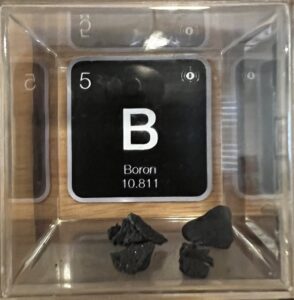Boron
Atomic Number: 5
Atomic Mass: 10.811 u

Boron, while not as well-known as some elements, plays a critical role in many modern technologies and industries. Its unique properties have made it indispensable in fields ranging from agriculture to aerospace. Let’s take a look at the fascinating history of this element, its discovery, and how it is used in our world today.
The Discovery of Boron: A Team Effort
The history of boron’s discovery is a bit of a journey. Although compounds containing it were used long before its official identification, it wasn’t until the early 19th century that it was isolated as an element. In 1808, two chemists, Sir Humphry Davy in England and Joseph-Louis Gay-Lussac in France, independently succeeded in isolating the element by using different methods to extract it from boric acid.
Boron was first found in nature in compounds like borax, a mineral that had been used for cleaning and glassmaking for centuries. However, the element in its pure form remained elusive until Davy and Gay-Lussac’s work. They were able to confirm that it was a unique element, separate from the compounds it was originally found in.
Modern-Day Uses of Boron
Today, boron has found its way into a wide variety of uses, thanks to its unique chemical and physical properties. Here are some of the most important areas where it is applied:
- Agriculture: One of the most vital roles of boron is in agriculture. It is an essential micronutrient for plants, playing a key role in cell wall formation, nutrient transport, and reproductive processes. A deficiency can lead to poor crop yields, making it a critical element in fertilizers for sustainable farming.
- Glass and Ceramics: Perhaps one of its most famous uses is in borosilicate glass, a type of glass known for its resistance to heat and thermal shock. This glass is used in everything from laboratory equipment to cookware, making it a staple in both industrial and household settings. Boron also contributes to the hardness and durability of ceramic materials.
- Nuclear Applications: It’s ability to absorb neutrons makes it incredibly valuable in the nuclear industry. Boron-10, an isotope of the element, is used as a control agent in nuclear reactors, where it helps regulate fission reactions. Additionally, boron compounds are used in radiation shielding to protect workers in nuclear facilities.
- Pharmaceuticals: Boron plays a role in modern medicine, too. Boron-containing compounds are used in certain drugs and therapies, including those for treating fungal infections and some cancers. Research is ongoing into how boron-based compounds can be used to create new drugs that target specific diseases with greater precision.
- Electronics and Technology: In the electronics industry, boron is used as a dopant in semiconductors, where it helps to control the electrical properties of silicon. This makes it essential in the production of computer chips, smartphones, and other electronic devices that form the backbone of modern communication and technology.
- Aerospace and Defense: Boron fibers, incredibly strong and lightweight, are used in advanced aerospace materials. These fibers are incorporated into high-strength composites for military and civilian aircraft, as well as space exploration vehicles, where minimizing weight while maintaining structural integrity is crucial.
- Renewable Energy: Boron is also finding a place in the renewable energy sector. It is used in the production of solar cells, particularly in high-efficiency photovoltaic technologies. As the world moves toward more sustainable energy sources, boron’s role in this sector is likely to grow.
The Future of Boron
Looking ahead, boron is poised to play an even greater role in the development of next-generation technologies. From advancements in battery technologies, where boron may enhance energy storage, to its continued use in cutting-edge materials science, boron’s unique characteristics make it an element of the future.
Research into boron’s potential in fields like nanotechnology and materials engineering promises to unlock new possibilities. As we continue to explore the versatility of this element, it’s clear that its impact on modern life is far-reaching and only growing.
Conclusion
Boron may not be a household name, like gold, but its influence is all around us. From the food we eat to the technology in our pockets and the glass in our kitchens, this element touches many aspects of our daily lives. Discovered more than two centuries ago by pioneering chemists, boron continues to shape industries and technologies that define the modern world. As research expands and new applications are discovered, its importance is only set to increase.
 using WordPress and
using WordPress and
No responses yet